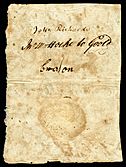North Carolina pound facts for kids
Quick facts for kids North Carolina pound |
|||||
|---|---|---|---|---|---|
|
|||||
| User(s) | North Carolina | ||||
| Pegged with | sterling at £1 N.C. = 15/- STG (£0.75 STG) | ||||
| Symbol | £ | ||||
| Plural | pounds | ||||
| Coins | None | ||||
| Banknotes | |||||
| Freq. used | £1, £2, £5 | ||||
| Rarely used | £3 | ||||
The pound (symbol: £) was the money used in North Carolina a long time ago. It was the official currency until the year 1793.
When North Carolina was a British colony, people first used British money called sterling coins. But over time, they needed their own money.
Contents
North Carolina's Own Money
Starting in 1709, North Carolina began to print its own paper money. This was called "colonial currency." It was divided into pounds, shillings, and pence, just like British money.
How Much Was It Worth?
The money made in North Carolina was not worth as much as British sterling. For example, one North Carolina shilling was worth nine pence of British sterling. This meant one North Carolina pound was worth 15 shillings of British sterling.
Different Kinds of Paper Money
The first paper money issued by North Carolina was known as "Old Tenor" money. Later, in 1748, a new type of paper money was introduced. This was called "New Tenor" money. It was worth much more than the "Old Tenor" notes. One "New Tenor" note was equal to seven and a half "Old Tenor" notes.
The End of the North Carolina Pound
After the American colonies became the United States, things changed. North Carolina started using "continental currency." This money was also in pounds, shillings, and pence. It also used Spanish dollars. One Spanish dollar was equal to eight shillings of this continental currency.
Eventually, the continental currency was replaced by the U.S. dollar. This happened at a rate of 1000 continental dollars for just one U.S. dollar. This change marked the end of the North Carolina pound.



